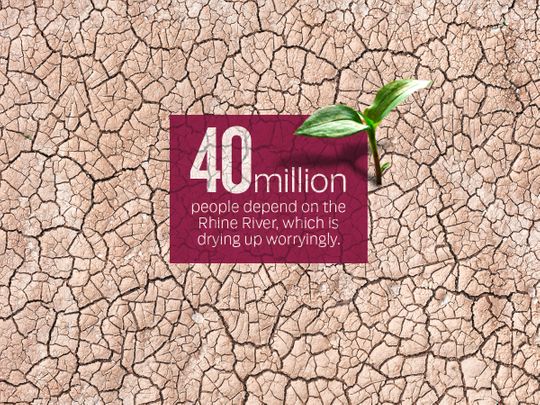
Discussion about the impacts of climate change on the water system is mostly focused on glacier melting or sea level rise but not much on the rivers and lakes that supply a significant share of the freshwater for human use.
River and lake systems are going through major changes worldwide due to warming temperatures and shifts in rainfall or snowfall patterns.
In some places, water flow in the rivers is becoming increasingly abundant, and in many other places, people and ecosystems are suffering desperately due to the shortage of water supply.
While Pakistan is facing a severe flood situation, there are many countries in the Northern Hemisphere, where rivers and lakes have dried up as never before.
Due to the lack of rain and increasingly frequent heatwaves, water flows in many major rivers have alarmingly reduced from North America to Europe, from the Middle East to East Asia. The water table of extremely important and historically conflict-prone Colorado has been falling for decades.
It has reached such a level that this summer, the mighty Lake Mead behind the Hoover Dam has almost become a dead pool. More than 40 million people depend on the Rhine River, which is drying up worryingly.

The agreement over water transportation on the Rhine was the founding stone for the creation of the European Union.
The water levels in that river in some places in Germany have fallen to as low as 32 centimetres, making it almost impossible for the container ships to operate. The so-called “hunger stones” have again surfaced in Germany’s Rhine River and the Czech Republic’s Elbe River.
Italy’s Po River has seen many floods recently, but this summer, a 2nd World War era bomb was found on its riverbed because the water flow has almost dried up.
France has been forced to reduce the operation of some of its nuclear power plants because the Rhone and Garonne Rivers’ water temperature was too high to be used for plant-cooling purposes.
Drought has also dried up the source of England’s Thames River. Many important rivers in Europe, the Danube, Guardiana, and the Loire, also face severe water scarcity. As per the European Drought Observatory, nearly half of Europe is under a drought warning, and this probably has never happened in the last 500 years.
China is also witnessing record-breaking drought from terrible heatwaves. The new climate has caused several rivers of the country to dry up, including the Yangtze. The gigantic Yangtze supplies more than 400 million people with drinking water and is crucial to China’s burgeoning economy.
Decline in rainfall
Its water flows this year have gone down to half of the average of the last five years, mainly due to a 45 per cent decline in rainfall in the basin, creating massive disruption to shipping and a drop in hydropower production.
Sichuan province is highly dependent upon hydropower, but the water table of the reservoirs is fast declining, resulting in the rationing of power supplies to thousands of factories.
Falling water levels of the Yangtze River have even brought three 600-years old Buddhist statues, which were hidden underwater, out in the open.
Growing water demand and an increasingly warming planet have not only resulted in the decline of water flow in river systems, but several major freshwater lakes are also drying up.
The water bodies of the Aral Sea in Central Asia, Lake Poopó in Bolivia, Lake Chad in Central Africa, and Owens Lake in California have been continuously shrinking, creating a serious ecological crisis in and around these lakes and bringing more challenges to food production, drinking water supply, trade, and transport.
Shifting precipitation and excessive evaporation have significantly declined the water volumes in rivers and lakes in many parts of the world.
The drying up of rivers and lakes has not only adversely affected irrigation, navigation, and industrial production; it has also led to the rising level of pollution as less water in the system fails to dilute even relatively common pollutants.
Higher pollution levels
Higher pollution and rising water temperature in rivers and lakes kill fish, plants, and wildlife. The climate crisis has changed the weather pattern, significantly impacting rivers and lakes and the people and ecosystems dependent on them.
Moreover, most of these rivers and lakes are transboundary and shared between two or more countries. Formal and informal norms and institutions have been developed among the basin countries from Colorado to the Rhine, from the Danube to the Euphrates-Tigris to the Aral Sea over the water sharing.
However, these existing water sharing mechanisms or basin-based water management institutions are proving inadequate to guide the path of cooperation over freshwater because climate change has brought unprecedented reduction to its availability.
While the old water agreements on rivers and lakes are under severe pressure, it is becoming almost impossible to sign new agreements on water sharing.
Climate change has already changed the water balance of the planet, and it has significantly altered the river flow in many parts of the world, and it will continue in the future.
This year’s drying up of rivers and lakes will not remain a one-year event; this phenomenon is likely to repeat more often. Thus, the world must come together to prioritise its fight against climate change.










